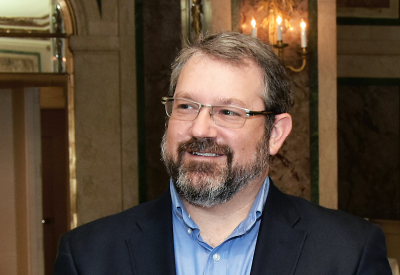Promise and Reality of Genomics: Link to Schizophrenia Involves Lots of Unknowns
Abstract
Hundreds of possible gene mutations may act alone or with each other to determine phenotypic expression of schizophrenia.
Better treatments for schizophrenia rely on a more complete understanding of how genetic mutations alter the activity of neural circuits in patients with the disease.

NIMH Director Joshua Gordon, M.D., says extremely large study cohorts are necessary to help prioritize targets for genetic research in schizophrenia.
That’s the message National Institute of Mental Health (NIMH) Director Joshua Gordon, M.D., delivered to researchers and clinicians during a plenary lecture at the International Congress of Schizophrenia Research in San Diego in March.
Gordon said the path forward for genomics and schizophrenia, though promising, is extraordinarily daunting: hundreds of potential gene mutations act through the same complex chain—genes to molecules to cells to circuits to behavior—resulting in a diversity of possible phenotypes. This wide range of phenotypes accounts for what has traditionally been called the “heterogeneity” of schizophrenia.
“There is the promise of genetics, and there is the reality,” Gordon said at the meeting. “The reality is that there are hundreds of genes that contribute to subsyndromal or syndromal schizophrenia, and each one of these mutations has a very small effect size. There is a lot of biology [between the mutation and the phenotypic expression of disease] that we don’t understand. When you throw in environmental influences, it makes the complexity picture completely non-linear.”
Gordon gave an example of how genetics contribute to understanding the differential phenotypic expression of schizophrenia based on his own work at Columbia University and the New York Psychiatric Institute prior to his becoming director of NIMH.
He and colleagues focused on the 22q11 microdeletion, a tiny mutation in a portion of chromosome 22 known to be associated with schizophrenia and cognitive deficits. They found that mice bred with the 22q11 microdeletion took longer to learn a working memory task than those that did not have the mutation.
Additional analyses suggested that the working memory impairments in the mice appear to be due to disrupted communication between the hippocampus and the prefrontal cortex, where spatial information is encoded in memory. Even further, Gordon and his long-time collaborator Joseph Gogos, M.D., Ph.D., were able to elucidate neurochemical abnormalities in the development of axons (the threadlike fibers from a neuron that transmit information to another neuron), which appear to account for disrupted communication between the hippocampus and prefrontal cortex.
Gordon said this work illustrates how genetic mutations and the various behavioral phenotypes associated with schizophrenia can be linked to offer a more complete understanding of the neurobiology of the disorder. In this case, one phenotypic expression (impaired working memory) is associated with a genetic mutation (22q11) that is linked to cells and neural networks specifically associated with disrupted communication of information between two brain structures (the hippocampus and prefrontal cortex).
Yet as elegant as it appears, Gordon said it almost certainly oversimplifies the true picture of what happens in schizophrenia. “The bigger problem is that it represents only a portion of what we know about schizophrenia genetics,” Gordon said, with hundreds of other possible gene mutations that may act alone or in concert with each other to determine phenotypic expression.
What is necessary and what Gordon said he and other researchers hope to find is “critical convergence” of research findings—“where some significant amount of schizophrenia is explained by one common convergent pathophysiology.”
For that, he said, it will be necessary to collect data on extremely large population cohorts to link genomics to phenotypes.
That’s an enormous undertaking. Gordon said he has appointed the Workgroup on Genomics of the National Advisory Mental Health Council and charged it with answering the following questions:
What are the best strategies for prioritizing genetic signals/genes for functional analyses?
What are the best experimental and computational tools for investigating genetic risk factors?
How can NIMH leverage diverse population-based cohorts to enable large-scale genomic discovery?
How should dimensional phenotypes be used to further elucidate the genetic architecture of mental disorders?
In the meantime, Gordon suggested the way forward toward better treatment of patients with schizophrenia is to leverage developing integrated care networks to make the treatments that exist—antipsychotic medication and evidence-based psychosocial therapies—available to patients in primary care.
“But I deeply believe that in order to truly transform the efficacy of drug treatment for schizophrenia we need to understand the neurobiology of the disease,” he said. ■



